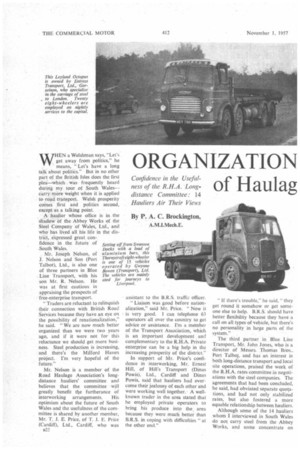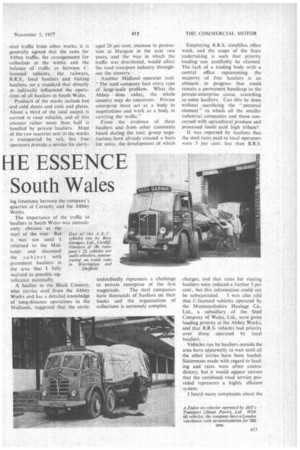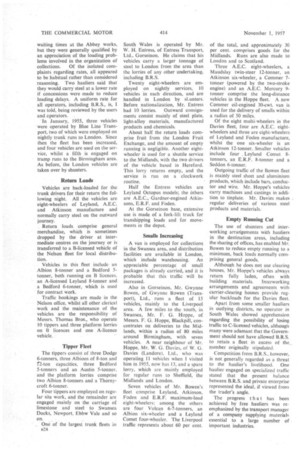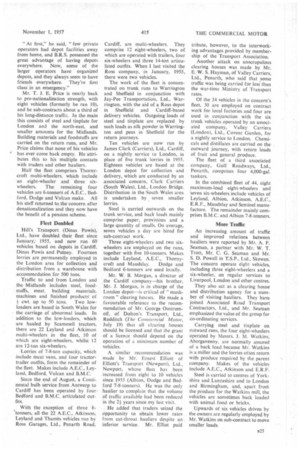Confidence in the Usefulness of the R.H.A. Longdistance Committee: 14 Hauliers Air Their Views
Page 56

Page 57

Page 58

Page 63

If you've noticed an error in this article please click here to report it so we can fix it.
By P. A. C. Brockington,
\ATHEN a Welshman says, "Let's get away from politics," he means, "Let's have a long talk about politics." But in no other part of the British Isles does the first plea—which . was frequently heard during my tour of South Wales-carry more weight when it is applied to road transport. Welsh prosperity wines first and politics second, except as a talking point.
A haulier whose office is in the 'shadow Of the Abbey Works of the Steel Company of Wales, Ltd., and who has lived all his life in the district, expressed great con fidence in the future of South Wales.
Mr. Joseph Nelson, of J. Nelson and Son (Pori Talbot), Ltd., is also one of three partners in Blue Line Transport, with his son Mr. R. Nelson. He was at first cautious in appraising the prospects of free-enterprise transport.
"Traders are reluctant to relinquish their connection with British Road Services because they have an eye on the possibility of renationalization," he said. "We are now much better organized than we were two years ago, and if it were not for this reluctance we should get more business. Steel production is increasing, and there's the Milford Haven project. I'm very hopeful of the future."
Mr. Nelson is a member of the Road Haulage Association's longdistance hauliers' committee and believes that the committee will greatly benefit the furtherance of in terworking arrangements. His optimism about the future of South Wales and the usefulness of the committee is shared by another member, Mr. T. J. E. Price, of T. J. E. Price (Cardiff), Ltd., Cardiff, who was assistant to the B.R.S. traffic officer.
"Liaison was good before nationalization," said Mr. Price. " Now it is very good. I can telephone 63 operators all over the country to get advice or assistance. I'm a member of the Transport Association, which is an important development . and complementary to the R.H.A. Private enterprise can be a big help in the increasing prosperity of the district."
In support of Mr. Price's confidence in interworking, Mr. Ernest Hill, of Hill's Transport (Dinas Powis), Ltd., Cardiff and Dinas Powis, said that hauliers had overcome their jealousy of each other and were working well together. A wellknown trader in the area stated that he employed private operators to bring his produce into the, area because they were much better than B.R.S. in coping with difficulties "at the other end."
If there's trouble," he said, "they get round it somehow or get someone else to help. B.R.S. should have better flexibility because they have a call on all types of vehicle, but there's no personality in large parts of the system."
The third partner in Blue. Line Transport, Mr. John Jones, who is a director of Messrs. Thomas Bros., Port Talbot, and has an interest in both long-distance transport and local site operations, praised the work of the R.H.A. rates committee in negotiations with the steel companies. The agreements that had been concluded, he said, had obviated separate quotations, and had not only stabilized rates, but also fostered a more equable relationship between hauliers.
Although some of the 14 hauliers whom I interviewed in South Wales do not carry steel from the Abbey Works, and some concentrate on
steel traffic from other works, it is generally agreed that the rates for Abbey traffic, the arrangements for collection at the works and the balance of traffic as between Clicensed vehicles, the railways, B.R.S., local hauliers and visiting hauliers, set a standard that directly or indirectly influenced the operations of all hauliers in South Wales, Products of the works include hot and cold sheets and coils and plates. About a third of the total output is carried in road vehicles, and of this amount rather more than half is handled by private hauliers. Most of the raw material sent to the works is transported by rail, but free operators provide a service for carry
ing limestone between the company's quarries at Comely and the Abbey Works.
The importance of the traffic to hauliers in South Wales was immediately obvious at the start of the tour. But it was not until I returned to the Midlands and discussed the subject with prominent hauliers in the area that I fully realized its possible significance nationally.
A hauler in the Black Country, who carries steel from the Abbey Works and has a detailed knowledge of long-distance operations in the Midlands, suggested that the envis
aged 20 per cent, increase in production at Margam in the next two years, 'and the way in which the traffic was distributed, would affect the road transport industry throughout the country.
Another Midland operator said: "The steel company face every type of large-scale problem. What the Abbey does today, the whole country may do tomorrow. Private enterprise must act as a body in negotiations and work as a body in carrying the traffic."
From the evidence of these hauliers and from other comments heard during the tour, group negotiations have already created a basis for unity, the development of which undoubtedly represents a challenge to private enterprise of the first magnitude. The steel companies have thousands of hauliers on their books and the organization of collections is extremely complex. 'Employing B.R.S. simplifies office work, and the scope of the State undertaking is such that priority loading can justifiably be claimed. The lack of a trading body with a central office representing the majority of free hauliers is an obstacle to progress that could remain a permanent handicap to the private-enterprise cause, according to some hauliers. Can this be done without ,sacrificing the "personal element" to which all the smaller industrial companies and those concerned with agricultural produce and processed foods paid high tribute?
It was reported by hauliers that the steel rates paid to local operators were 5 per cent. less than B.R.S.
charges, and that rates for visiting hauliers were reduced a further 5 per cent., but this information could not be substantiated. I was also told that C-licensed vehicles operated by the Monmouthshire Haulage Co., Ltd., a subsidiary of the Steel Company of Wales. Ltd.. were given loading priority at the Abbey Works, and mat B.R.S. vehicles had priority over those operated by local hauliers.
Vehicles run by haulers outside the area have apparently to wait until all the other lorries have been loaded. Statements made with regard to loading and rates were often contradictory, but it would appear certain that the combined road service provided represents a highly efficient system.
heard many complaints about the waiting times at the Abbey works, but they were generally qualified by an appreciation of the loading problems involved in the organization of
collections. Of the isolated complaints regarding rates, all appeared to be habitual rather than considered reasoning. Two hauliers said that they would carry steel at a lower rate if concessions were made to reduce loading delays. A uniform rate for all operators, including B.R.S., is, I was told, being reviewed by the users and operators. .
In January, 1955, three vehicles were operated by Blue Line Transport, two of which were employed on nightly trunk runs to London. Since then the fleet has been increased, and four vehicles are used on the service, whilst a fifth is engaged on tramp runs to the Birmingham area. As before, the London vehicles are taken over by shunters.
Return Loads
Vehicles are back-loaded for the trunk drivers for their return the following night. All the vehicles are eight-wheelers of Leyland, A.E.C. and Atkinson manufacture and normally carry steel on the outward journey.
Return loads comprise general merchandise, which is sometimes dropped by the driver at intermediate centres on the journey or is transferred to a B-licensed vehicle of the Nelson fleet for local distribution.
Vehicles in this fleet include an Albion 8-tonner and a Bedford 5tonner, both running on B licences. an A-licensed Leyland 8-tonner and a Bedford 6-tonner, which is used for contract work.
Traffic bookings are made in the Nelson office, whilst all other clerical work and the maintenance of the vehicles are the responsibility of Messrs. Thomas Bras., who operate 10 tippers and three platform lorries on B licences and one A-licence vehicle.
Tipper Fleet
The tippers consist of three Dodge 6-tonners, three Albions of 8-ton and c2-ton capacities, three Bedford 5-tanners and an Austin 5-tanner. and the platform lorries comprise two Albion 8-tonners and a Thornycroft 6-tonner.
Four tippers are employed on regular site work, and the remainder are engaged mainly on the carriage of limestone and steel to Swansea Docks, Newport, Ebbw Vale and so on.
One of the largest trunk fleets In South Wales is operated by Mr. W. H. Entress, of Entress Transport, Ltd.. Gorseinon. He claims that his vehicles carry a larger tonnage of steel to London from the area than the lorries of any other undertaking, including B.R.S.
Twenty eight-wheelers are employed on nightly services, 10 vehicles in each direction, and are handled in London by sl.unters. Before nationalization, Mr. Entress
had 10 lorries. Outward consignments consist mainly of steel plate, light-alloy materials, manufactured products and chemicals.
About half the return loads comprise fruit from the London Fruit Exchange, and the amount of empty running is negligible. Another eightwheeler is used for a shuttle service to the Midlands, with the two drivers of the vehicle based in Hereford. This lorry returns empty, and the service is run on a clockwork routine. • Half the Entress vehicles are Leyland Octopus models; the others are A.E.C., Gardner-engined Atkinsons, E.R.F. and Foden.
At the Gorseinon base, extensive use is made of a fork-lift truck for transhipping loads and for movements in the depot.
Smalls Increasing
A van is employed for collections in the Swansea area, and distribution facilities are available in London, which include warehousing. An appreciable percentage of small packages is already carried, and it is probable that this traffic will be increased.
Also in Gorseinon, Mr, Gwynne Bowen, of Gwynne Bowen (Transport), Ltd., runs a fleet of 15 vehicles, mainly to the Liverpool area. A few miles to the south, in Swansea, Mr. F. G. Hoppe, of Messrs. F. G. Hoppe, Blackpill, concentrates on deliveries to the Midlands, within a radius of 80 miles around Birmingham, with seven vehicles. A near neighbour of Mr. Hoppe. Mr. W. G. Davies, of W. 0. Davies (Landore). Ltd., who was operating 11 vehicles when I visited him in 1955, now has 13, and a spare lorry, which are mainly employed for regular runs to Sheffield, the Midlands and London.
Seven vehicles of Mr. Bowen's fleet comprise Leyland, Atkinson. Foden and E.R.F. maximum-load eight-wheelers: among the others are four Vulcan 6-7-tonners, an Albion six-wheeler and a Leyland Comet four-wheeler. The Liverpool traffic represents about 60 per cent.
of the total, and approximately 30 per cent. comprises goods for the Midlands. Runs are also made to London and to Scotland.
Three A.E.C. eight-wheelers, a Maudslay twin-steer 12-tonner, an Atkinson six-wheeler, a Commer 7tonner (powered by the two-stroke engine) and an A.E.C. Mercury 9tonner comprise the long-distance vehicles in the Hoppe fleet. A new Commer oil-engined 30-cwt. van is used for the delivery of smalls within a radius of 50 miles.
Of the eight multi-wheelers in the Davies fleet, four are A.E.C. eightwheelers and three are eight-wheelers of Leyland and Foden manufacture, whilst the one six-wheeler is an Atkinson 12-tonner. Smaller vehicles include four Leyland Comet 8tanners, an E.R.F. 8-tonner and a Seddon 6-tanner.
Outgoing traffic of the Bowen fleet is mainly steel sheet and aluminium products, which include bars, conductor and wire. Mr. Hoppe's vehicles carry machines and castings in addition to tinplate. Mr. Davies makes regular deliveries of various steel products and materials.
Empty Running Cut
The use of shunters and interworking arratigements with hauliers in the destination areas, including the sharing of offices, has enabled Mr. Bowen to reduce empty running to a minimum, back loads normally comprising general goods.
Although he does not use clearing houses. Mr. Hoppe's vehicles always return fully laden, often with building materials. In tcrworking arrangements and agreements with carrier-clearing houses provide regular backloads for the Davies fleet.
Apart from some smaller hauliers in outlying districts, no operator in South Wales showed apprehension regarding the possibility of losing traffic to C-licensed vehicles, although many were adamant that the Government should not have allowed B.R.S. to retain a fleet in excess of the number originally stipulated.
Competition from B.R.S.. however, is not generally regarded as a threat to the haulier's livelihood. One haulier engaged on specialized traffic stated that the present balance between B.R.S. and private enterprise represented the ideal, if viewed from the trader's angle.
The progress that has been achieved by free hauliers was reemphasized by the transport manager of a company supplying materials essential to a large number of important industries. " At first," he said, "few private operators had depot facilities away from home, and B.R.S. possessed the great advantage of having depots everywhere. Now, some of the larger operators have organized depots, and they always seem to have friends everywhere. They're first class in an emergency."
Mr. T. J. E. Price is nearly back to pre-nationali7ation strength, with eight vehicles (formerly he ran 10), and he sub-contracts about a third of his long-distance traffic. In the main this consists of steel and tinplate for London and the north-east, and smaller amounts for the Midlands. Building materials and foodstuffs are carried on the return runs, and Mr. Price claims that none of his vehicles " has ever come back empty. He attributes this to his multiple contacts with traders and other hauliers.
Half the fleet comprises Thornycroft multi-wheelers, which include an eight-wheeler and three sixwheelers. The remaining four vehicles are 6-tonners of A.E.C., Bedford, Dodge and Vulcan make. All his staff returned to the concern after denationalization and they now have the benefit of a pension scheme.
Fleet Doubled
Hill's Transport (Ulnas Powis). Ltd., have doubled their fleet since January, 1955, and now run 60 vehicles based on depots in Cardiff. Dinas Powis and Putney. Fourteen lorries are permanently employed in the London area for collection and distribution from a warehouse with accommodation for 500 tons.
Traffic to and from London and the Midlands includes steel, foodstuffs, meat, building materials. machines and finished products of
T, cwt. up to 50 tons. Two lowloaders are based in South Wales for the carriage of abnormal loads. In addition to the low-loaders, which are hauled by Scammell tractors, there are 22 Leyland and Atkinson multi-wheelers in the fleet, 10 of which are eight-wheelers, whilst 12 are 12-ton six-wheelers.
Lorries of 7-8-ton capacity, which include meat vans, and four tractortrailer outfits, form the remainder of the fleet. Makes include A.E.C, Leyland, Bedford, Vulcan and B.M.C.
Since the end of August, a Continental bulb service from Antwerp to Cardiff has been operated by four Bedford and B.M.C. articulated outfits.
With the exception of three 8tanners, all the 22 A.E.C., Atkinson, Leyland and Thames vehicles run by Ross Garages, Ltd., Penarth Road, Cardiff, are multi-wheelers. They comprise 12 eight-wheelers, two of which are operated with trailers, four six-wheelers and three 14-ton articulated outfits. When 1 last visited the Ross company, in January, 1955, there were two vehicles.
The work of the fleet is concentrated on trunk runs to Warrington and Sheffield in conjunction with Jay-Pee Transportation, Ltd., Warrington, with the aid of a Ross depot in Sheffield and Cardiff-based delivery vehicles. Outgoing loads of steel and tinplate are replaced by such loads as silk powder in Warrington and peas in Sheffield for the return journeys.
Ten vehicles are now run by James Clark (Carriers), Ltd., Cardiff, on a nightly service to London, in place of five trunk lorries in 1955. Eighteen vehicles are based at the London depot for collection and delivery, which are conducted by an associated concern, Clark Carriers (South Wales), Ltd., London Bridge. Distribution in the South Wales area is undertaken by seven smaller lorries.
Steel is carried outwards on the trunk service, and back loads mainly comprise paper, provisions and a large quantity of smalls. On average, seven vehicles a day are hired for sub-contract work.
Three eight-wheelers and two sixwheelers are employed on the runs, together with five 10-tonners. Makes include Leyland, A.E.C., Thorny
croft and Maudslay. Dodge and Bedford 6-tormers are used locally.
Mr. W. B. Morgan, a director of the Cardiff company—his brother, Mr. J. Morgan, is in charge of the London depot—is critical of " mushroom " clearing houses. He made a favourable reference to the recommendation of Mr. George Oustromoff, of Dolton's Transport, Ltd., Redditch (The Commercial Motor, July 19) that all clearing houses should be licensed and that the grant of a licence should depend on the operation of a minimum number of vehicles.
A similar recommendation was made by Mr. Ernest Elliott of Elliott's Transport (Newport), Ltd., Newport, whose fleet has been increased from eight to 10 vehicles since 1955 (Albion, Dodge and Bedford 7-8-tonners). He was the only haulier to complain that the volume of traffic available had been reduced in the 2-1years since my last visit.
He added that traders seized the opportunity to obtain lower rates from cut-throat hauliers despite an inferior service. Mr. Elliot paid tribute, however, to the interworking advantages provided by membership of the Transport Association.
Another attack on unscrupulous clearing houses was, made by Mr.
E. W. S. Hayman, of Valley Carriers, Ltd., Penarth, who said that some traffic was being carried for less than the war-time Ministry of Transport rates.
Of the 34 vehicles in the concern's fleet, 30 are employed on contract work for local factories and four are used in conjunction with the six trunk vehicles operated by an associ ated company, Valley Carriers (London), Ltd., Covent Garden, for a nightly service to London. Chemi cals and distillates are carried on the outward journey, with return loads of fruit and general produce.
The fleet of a third associated company, Gulf Roadways, Ltd., Penarth, comprises four 4,000-gal. tankers.
In the combined fleet of 44, eight maximum-load eight-wheelers and seven six-wheelers include vehicles of Leyland, Albion, Atkinson, A.E.C., E.R.F., Maudslay and Sentinel manu facture. The remainder mainly comprises B.M.C. and Albion 7-8-tonners.
More Traffic
An increasing amount of traffic and improved relations between hauliers were reported by Mr. A. F. Seaman, a partner with Mr. W, T. Trott, Mr. C. G. Seaman and Mr. S. D. Powell in T.S.P., Ltd., Skewen. The concern operate eight vehicles, including three eight-wheelers and a six-wheeler, on regular services to Liverpool, London and other centres.
They also act as a clearing house and distribution agency for a number of visiting hauliers. They have joined Associated Road Transport Contractors, Ltd., and Mr. Seaman emphasized the value of the group for co-ordinating services.
Carrying steel and tinplate on outward runs, the four eight-wheelers operated by Messrs. J. M. Watkins, Abergavenny. are normally assured of a back load because Mr. Watkins is a miller and the lorries often return with produce required by the parent company. Makes of the vehicles include A.E.C., Atkinson and E.R.F.
Steel is carried to centres of York-, 'shire and Lancashire and to London and Birmingham, and, apart from the produce for the Watkins mill, the vehicles are sometimes back loaded with animal food or bricks.
Upwards of six vehicles driven by the owners are regularly employed by Mr. Watkins on sub-contract to move smaller loads.
























































































































